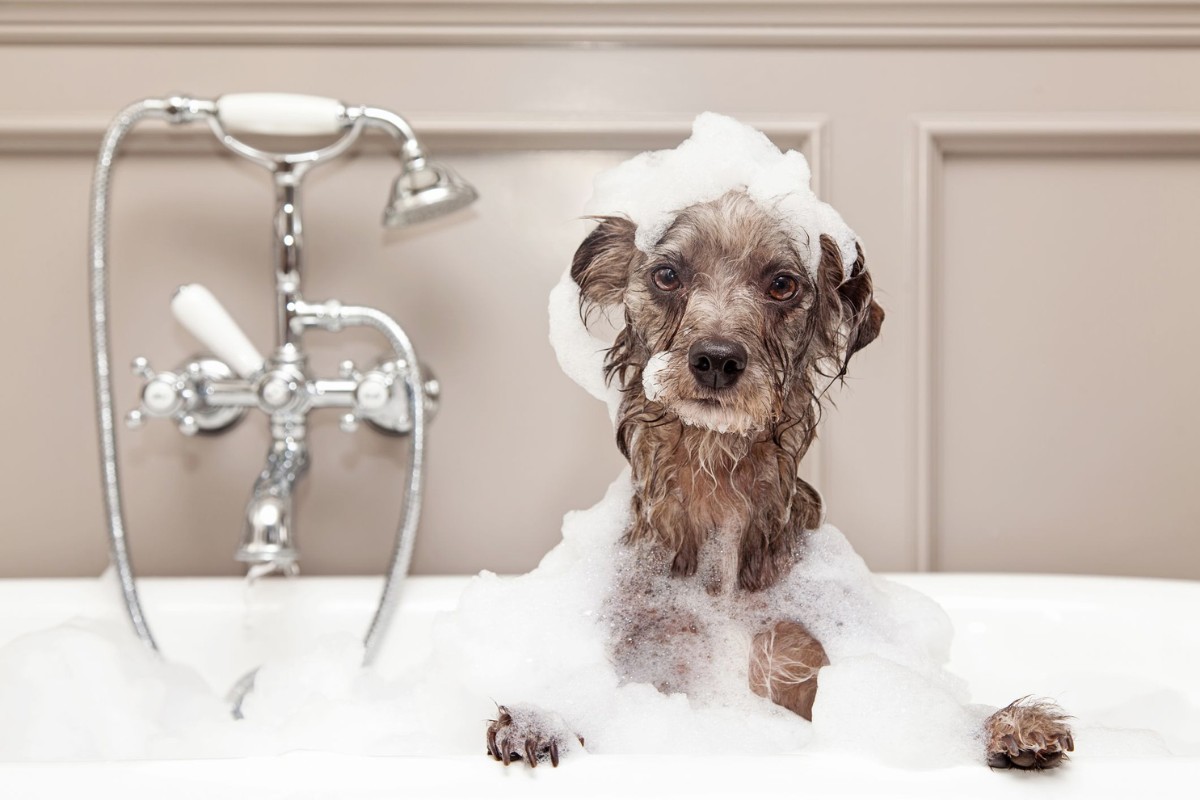 2 Nov
2 NovCan You Use Cat Shampoo On A Dog?
As a devoted dog owner, ensuring the well-being of our furry companions is paramount. One question that might have crossed your mind is whether it’s okay to use cat shampoo on a dog. It’s a common consideration, especially in moments of convenience or when the right dog shampoo isn’t readily available.
In this article, we’ll cut through the confusion and provide straightforward guidance. We’ll discuss the fundamental differences between cat and dog shampoos, the potential risks of using the wrong type, and circumstances where it might be acceptable.
No, it’s not recommended to use cat shampoo on a dog. Cat and dog shampoos are formulated differently based on each species’ unique pH levels and skin conditions. Using cat shampoo on a dog may lead to skin irritation, dryness, or allergic reactions. For optimal dog care, choosing a shampoo specifically designed for dogs is essential.

Risks of Using Cat Shampoo on Dogs
While the temptation to use cat shampoo on your dog may arise in a pinch, it’s essential to understand the potential risks involved. Cat shampoo is formulated for feline-specific needs and may not be suitable for your canine companion. Let’s delve into the potential negative effects of using cat shampoo on dogs.
1. Skin Irritation, Dryness, and Allergic Reactions
One of the immediate risks of using cat shampoo on dogs lies in the formulation. Cat shampoos often contain ingredients tailored to the unique needs of feline skin and coat. These formulations may be too harsh or unsuitable for canine skin, which can be more sensitive.
The result? Skin irritation, dryness, and potentially allergic reactions. Dogs may exhibit signs of discomfort, including excessive scratching, redness, and even flaky skin. Prolonged exposure to unsuitable shampoos can lead to chronic skin issues that require veterinary attention.
2. Improper pH Levels and Long-Term Skin Problems
As mentioned earlier, cats and dogs have distinct pH levels in their skin. Using a shampoo formulated for a cat’s skin, which tends to be more neutral, can disrupt the acidic balance of a dog’s skin. This disruption may compromise the skin’s natural protective barrier, leaving it susceptible to irritants and pathogens.
Over time, the consequences can be more severe than just immediate discomfort. Long-term use of an unsuitable shampoo can lead to chronic skin problems, such as dermatitis or bacterial infections. These conditions often necessitate specialized treatment and can impact your dog’s overall well-being.
Safe Alternatives for Bathing Your Dog
Bathing is an integral part of dog care, promoting not only cleanliness but also overall health. With the myriad of products on the market, it’s paramount to choose those that align with your dog’s specific needs and offer optimal care. Here, we’ll discuss dog-specific shampoos, their benefits, and the perks of choosing natural and organic products for your beloved canine.
1. Dog-Specific Shampoos and Their Benefits
Unlike the generic or cross-species options, dog-specific shampoos are formulated with your pup’s unique skin and coat conditions in mind. They’re tailored to match the pH balance of canine skin, ensuring a gentle yet effective cleanse without disrupting the skin’s natural barrier.
Benefits include:
- Gentle Cleansing: These shampoos cleanse without stripping away essential oils, preventing dryness and irritation.
- Enhanced Coat Health: Many dog shampoos are enriched with vitamins and conditioners, promoting a shiny, healthy coat.
- Targeted Solutions: Dog shampoos are designed to address various canine-specific issues, from shedding to odor control.
2. Specialized Shampoo Options
Every dog is unique, and their grooming needs can be equally individual. Recognizing this, many brands offer specialized shampoos that cater to particular needs:
- Medicated Shampoos: Perfect for dogs with skin conditions or infections. They contain ingredients that soothe inflammation, tackle bacteria, or address specific skin issues.
- Hypoallergenic Shampoos: Crafted for dogs with sensitive skin or allergies, these shampoos often have minimal ingredients and avoid common allergens.
- Flea and Tick Shampoos: These help in repelling or killing fleas and ticks, offering a line of defense against these pesky critters.
- Puppy Shampoos: Gentle formulas tailored for the soft, sensitive skin of puppies.
3. The Importance of Natural and Organic Products
In recent years, there’s been a noticeable shift towards natural and organic pet care products, and for a good reason:
- Safety: Natural and organic shampoos are often free from harmful chemicals, parabens, and artificial fragrances that can irritate or harm your dog.
- Environmentally Friendly: Many of these products are biodegradable, making them a better choice for the environment.
- Effective Yet Gentle: Natural ingredients can offer potent benefits without the harsh effects of some synthetic alternatives.
Tips for Choosing the Right Shampoo for Your Dog
Choosing the right shampoo for your dog is more than just grabbing the first bottle you see on the store shelf. Like humans, dogs have unique needs based on their breed, age, and skin conditions. Here’s a checklist to guide you in making an informed decision:
1. Consider Your Dog’s Breed
Different breeds have distinct coat types. A Husky, with its thick double coat, might require a different shampoo than a Poodle with curly hair. It’s beneficial to look for a shampoo tailored to your dog’s specific breed or coat type.

2. Factor in Age
Puppies have more sensitive skin than adult dogs, so it’s essential to opt for shampoos that are gentle enough for them. On the other hand, older dogs might have drier skin and could benefit from moisturizing or hydrating shampoos.
3. Evaluate Skin Conditions
If your dog has a specific skin condition, like dryness, flakiness, or allergies, choose a shampoo that addresses these issues. Medicated or hypoallergenic shampoos can be a godsend for dogs with skin irritations or sensitivities.
4. Check Ingredients
Always read the label. Opt for shampoos that contain natural ingredients and avoid those with chemicals or additives that might be harmful. Ingredients like aloe vera, oatmeal, and chamomile can be soothing for many dogs.
5. Seek Recommendation
It never hurts to ask for advice. Your veterinarian or fellow dog owners can offer valuable insights. Additionally, online reviews can provide feedback on what’s worked well for other dogs.
When it comes to reputable dog shampoo brands, there are several that consistently receive high praise from veterinarians and pet owners alike:
- Earthbath: Known for its natural ingredients and a wide range of formulations to suit different dog needs.
- Burt’s Bees for Dogs: This brand offers a line of natural grooming products that cater to various skin conditions and coat types.
- Vet’s Best: As the name suggests, this brand offers medicated options and formulations that address specific skin issues.
How to Safely Bathe Your Dog
Bathing your dog can be a bonding experience that promotes their health and well-being. However, it’s important to approach it with care and attention to ensure it’s a positive experience for both you and your furry friend. Here’s a step-by-step guide on how to safely bathe your dog, with a focus on their comfort and safety.
Step 1: Preparation is Key
Before you even bring your dog into the bathroom, gather all the necessary supplies. You’ll need dog-specific shampoo, towels, a non-slip mat, a gentle brush, and a treat for positive reinforcement.
Step 2: Choose the Right Location
Select a suitable bathing area. This could be a bathtub or a designated spot outdoors if the weather permits. Ensure the area is secure and free of hazards that might cause your dog to slip or become anxious.
Step 3: Get the Water Temperature Right
Fill the tub with lukewarm water. It should be comfortably warm to the touch, similar to the temperature you would use for a baby’s bath. Avoid extremes in either direction, as dogs are sensitive to temperature changes.
Step 4: Introduce Your Dog to the Water
Gently lead your dog into the water, providing reassurance and speaking in soothing tones. Use a handheld sprayer or a cup to wet their coat, starting from the neck and working your way down. Be mindful to avoid getting water in their ears and eyes.
Step 5: Apply the Shampoo
Pour a small amount of dog-specific shampoo into your hand and lather it gently onto your dog’s coat. Start from the neck and work towards the tail, being cautious around sensitive areas like the face, ears, and genitals. Use a gentle massage motion to distribute the shampoo evenly.
Step 6: Rinse Thoroughly
Rinse your dog’s coat thoroughly to remove all the shampoo. Any leftover residue can cause irritation. Again, start from the neck and work towards the tail, avoiding the face.
Step 7: Mind Water Pressure
When using a handheld sprayer, use low water pressure to prevent startling or discomfort. Keep the water flow steady and controlled.
Step 8: Towel Dry with Care
After the bath, use a clean towel to pat your dog dry gently. Pay special attention to their paws and underbelly. If your dog has a long coat, be careful not to tug or pull on their fur.
Step 9: Use Positive Reinforcement
Praise and reward your dog throughout the process, especially if they exhibit calm and cooperative behavior. This positive reinforcement helps associate bath time with a positive experience.
Step 10: Post-Bath Care
Once your dog is dry, brush its coat. This not only helps remove any remaining tangles but also allows you to check for any unusual lumps, bumps, or skin issues.
Remember, patience and a calm demeanor are key to a successful bath time. By following these steps and prioritizing your dog’s comfort and safety, you can make bath time a pleasant and beneficial routine for both you and your furry companion.




